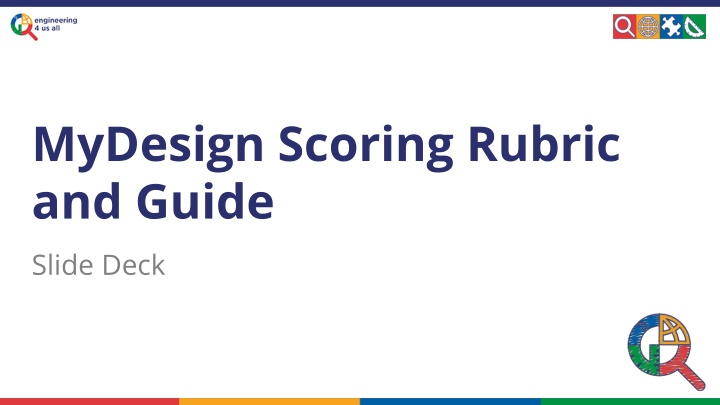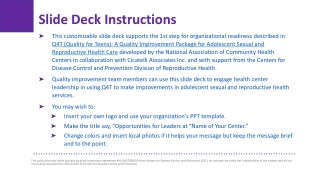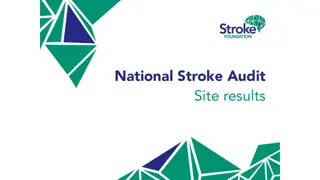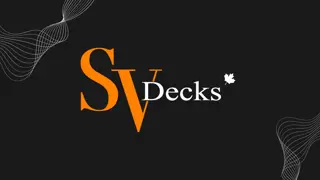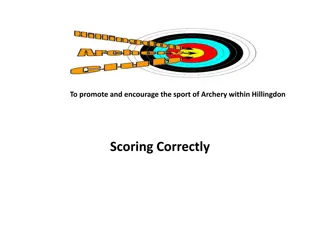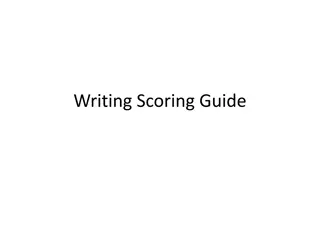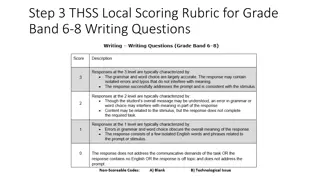Design Scoring Rubric and Guide Slide Deck
"This slide deck provides a structured approach for presenting, justifying, generating, and evaluating design solutions. It includes components like problem definition, solution requirements, prototype construction, evaluation, and recommendations."
Download Presentation

Please find below an Image/Link to download the presentation.
The content on the website is provided AS IS for your information and personal use only. It may not be sold, licensed, or shared on other websites without obtaining consent from the author.If you encounter any issues during the download, it is possible that the publisher has removed the file from their server.
You are allowed to download the files provided on this website for personal or commercial use, subject to the condition that they are used lawfully. All files are the property of their respective owners.
The content on the website is provided AS IS for your information and personal use only. It may not be sold, licensed, or shared on other websites without obtaining consent from the author.
E N D
Presentation Transcript
MyDesign Scoring Rubric and Guide Slide Deck
Table of Contents Introduction Component I: Presenting and Justifying a Problem and Solution Requirements Component II: Generating and Defending an Original Solution Component III: Constructing and Testing a Prototype Component IV: Evaluation, Reflection, and Recommendations
Jump to an Element Element A: Presentation and Justification of the Problem Element B: Documentation and Analysis of Prior Design Attempts Element C: Presentation and Justification of Solution Design Requirements Element D: Design Concept Generation, Analysis, and Selection Element E: Application of STEM Principles and Practices Element F: Consideration of Design Viability Element G: Construction of a Testable Prototype Element H: Prototype Testing and Data Collection Plan Element I: Testing, Data Collection, and Analysis Element J: Documentation of Evaluation Element K: Reflection on the Design Project Element L: Presentation of Designer's Recommendations
Introduction What is MyDesign? MyDesign is a tool that incorporates real engineering design practices to guide and strengthen your process. Why use MyDesign? Using MyDesign results in the creation of a portfolio that captures and showcases your engineering design process for a particular project.
Rubric Structure Criterion A1 Element A Criterion A2 Component I Element B Criterion A3 Component II Element C MyDesign Scoring Rubric Component III more criteria Component IV more elements
Component I: Presenting and Justifying a Problem and Solution Requirements Element A: Presentation and Justification of the Problem Element B: Documentation and Analysis of Prior Design Attempts Element C: Presentation and Justification of Solution Design Requirements click here to go back to start of slide deck
Element A: Presentation and Justification of the Problem In this element, you will: define the problem consider impacts research click here to go back to start of slide deck
A1. Problem identification is __________. missing (cannot be inferred from information included) score = 0 somewhat clear and objective somewhat clear or objective very clear and objective clear and objective unclear score = 5 score = 4 score = 3 score = 2 score = 1 Key Vocabulary "objective" means details, things we can measure Notes Identify the need. Move past describing the situation to describe how it is a problem. Make sure that the problem is explained in enough detail that anyone could understand the goal of this engineering design problem. Assume your reader knows nothing about the problem or its possible solutions. Include details that you might consider common knowledge.
A2. Problem definition is __________. missing (cannot be inferred from information included) score = 0 in more than adequate depth in considerable depth in adequate depth in superficial depth unclear score = 5 score = 4 score = 3 score = 2 score = 1 Notes Use your research to describe your problem in detail. In this element, focus on depth, not breadth. Depth means digging down into the problem, pulling out details that aren't noticeable at first. Define the problem by incorporating relevant research to get a 3 rating. Who is involved? What are they doing? Where is this happening? When does it occur? Why does it happen? How often does it happen? What unique situations does it occur within, if any? What is the size of the issue?
A3. Problem elaboration is __________. not elaborated (cannot be inferred from information included) score = 0 imprecisely or generally elaborated unelaborated and/or is clearly subjective well elaborated elaborated minimally elaborated score = 5 score = 4 score = 3 score = 2 score = 1 Key Vocabulary "elaboration" means breadth rather than depth Notes How does this problem relate to other contexts? Can solving this problem impact other stakeholders? How can this problem have consequences in other situations?
A4. Concern of primary stakeholder groups. Justification of the problem highlights the concerns of __________. at least a few primary stakeholders/ stakeholder groups score = 2 only one or two stakeholders/ stakeholder groups score = 1 no primary stakeholders/ stakeholder groups score = 0 almost all primary stakeholder groups many primary stakeholder groups several primary stakeholder groups score = 5 score = 4 score = 3 Key Vocabulary "primary stakeholders" are the ones most directly impacted by the problem "secondary stakeholders" may be impacted by a solution to the problem and are still part of the system Notes Identify primary and secondary stakeholders and their specific roles in the problem. In order to earn a score of 3, you will need to identify and highlight the concerns of several (more than three) primary stakeholder groups. You are encouraged to use cause and effect phrasing: Due to <insert stakeholder concern> there is a need to __________.
A5. Problem justification is based on __________. numerous, timely, credible, and various sources score = 5 essentially only the opinion of the researcher score = 0 timely, credible, and various sources credible and timely sources partially-credible sources credible sources score = 4 score = 3 score = 2 score = 1 Key Vocabulary "numerous" means 5 or more "timely" means sources are from the last ten years "credible" means sources are from peer reviewed journals, professional organizations, government agencies, and local and national newspapers "various sources" means sources come from 3 or more of the following categories: peer reviewed journals, professional organizations, government agencies, local and national newspapers Notes Use in-line citations to explicitly state which information is from which source. Do not just list all of the citations at the end of the submission or in footnotes. Cite at least 3 current, credible sources to get a "3" rating. These are the sources that you used to find data/statistics, the research to justify your problem statement, and the interview with the stakeholder(s). Use data and/or statistics to back up your argument (i.e. sources): Previous studies by __________ show that __________.
A6. Problem justification offers __________-objective detail. consistently mostly generally somewhat unclear no score = 5 score = 4 score = 3 score = 2 score = 1 score = 0 Notes Explain why it is important to solve this problem now with measurable data. Include data and statistics that helps the reader understand the severity of the problem. Convince your readers that the problem needs to be solved.
Element B: Documentation and Analysis of Prior Design Attempts In this element, you will: consider strengths and shortcomings of past and current attempts to solve the problem click here to go back to start of slide deck
B1. Documentation of plausible prior attempts to solve the problem and/or related problems is drawn from __________. several but not necessarily varied clearly-identified and generally- credible sources score = 3 a limited number of sources, some of which may not be clearly identified and/or credible a wide array of clearly- identified and consistently- credible sources a variety of clearly- identified and consistently- credible sources only one or two sources that may not be clearly identified and/or credible missing or minimal (a single source that is not clearly identified and/or credible) score = 5 score = 4 score = 2 score = 1 score = 0 Key Vocabulary "a wide array" = 5 or more, "a variety" = 4 , "several" = 3, "a limited number" = 2 "clearly identified" means you should cite at least 1 current, credible source for each prior solution with in-line citations (i.e. don't just give a list at the end of the element or footnote) "consistently credible" means sources are from peer-reviewed journals, professional organizations, government agencies, local and national newspapers, patents, and reputable vendors and manufacturers generally-credible means sources may be from TikTok, YouTube, Instagram, etc., and not from peer-reviewed sources, professional organizations, etc. Notes Don't use the same source to find information about all of your prior attempts. Get sources from a variety of places.
B2. The analysis of past and current attempts to solve the problem including both strengths and shortcomings __________. cannot be inferred from information intended as analysis of past and/or current attempts to solve the problem score = 0 is consistently clear, detailed, and supported by relevant data is clear, generally detailed, and supported by relevant data is generally clear and contains some detail and relevant supporting data is overly general and contains little detail and/or relevant supporting data is vague and is missing any relevant details and/or relevant supporting data score = 5 score = 4 score = 3 score = 2 score = 1 Notes Provide evidence and explain what parts of previous solutions were unsuccessful at solving the defined problem and why based on design requirements. Provide evidence and explain what parts of previous solutions were successful at solving the defined problem and why based on design requirements.
Element C: Presentation and Justification of Solution Design Requirements In this element, you will: determine the requirements for a design solution to be considered successful click here to go back to start of slide deck
C1. Determination of design requirements. __________ design requirements are related to prior research. 80%-100% of 60%-79% of 40%-59% of 20%-39% of 1%-19% of No score = 5 score = 4 score = 3 score = 2 score = 1 score = 0 Notes Your design requirements should be tethered to all that you've written in Element A. This subelement measures how many of your design requirements are related to the research you did and the information you found in Element A.
C2. Requirements list. Design requirements __________. are listed, formatted, and prioritization is attempted, but these may be partial and/or overly general score = 1 are listed and prioritized but some or all may be incomplete and/or lack specificity are listed, prioritized, generally clear, and detailed are listed, prioritized, generally clear, and somewhat detailed are listed, prioritized, clear, and detailed are not present or are too vague score = 5 score = 4 score = 3 score = 2 score = 0 Notes You must give a numbered prioritized list (and stated that it is prioritized) to get higher than a 0 AND state whether each requirement is high or low priority.
C3. Quantity of high-priority design requirements. __________ of the design requirements listed are identified as high priority. Five Four Three Two One None score = 5 score = 4 score = 3 score = 2 score = 1 score = 0
C4. Objective & measurable. Design requirements __________. are consistently objective and measurable score = 5 are nearly always objective and measurable score = 4 may be only sometimes objective and/or measurable score = 2 are generally objective and measurable are insufficiently measurable are not measurable score = 3 score = 1 score = 0 Key Vocabulary "objective" means details, things we can measure Notes Each design requirement needs to be measurable so one can objectively assess if that design requirement is valid.
C5. Leading to solution. Design requirements __________. would be highly likely to lead to a tangible and viable problem solution score = 5 would be likely to lead to a tangible and viable problem solution have a potential to lead to a tangible and viable problem solution have some potential to lead to a tangible and viable problem solution have little potential to lead to a tangible and viable problem solution cannot lead to a tangible and viable problem solution score = 4 score = 3 score = 2 score = 1 score = 0 Key Vocabulary "tangible and viable" means it can be touched (made in real life) and capable of working successfully (meets your design requirements) Notes The design requirements should be very clear and comprehensive so that they springboard you toward a solution. You are NOT looking to describe or really even formulate the specific design at this stage. That is for Elements D-F. You are simply focusing on the design requirements that lead to a solution. Take care to not list so many requirements that it becomes unlikely to create a viable solution--a viable solution must meet ALL requirements, so only list requirements that your successful design will meet. You may revisit this element as needed to reflect your design evolution.
C6. Primary stakeholder validation. There is evidence that requirements represent the needs of, and have been validated by, __________ primary stakeholder groups. 80%-100% of 60%-79% of 40%-59% of 20%-39% of 1%-19% of no score = 5 score = 4 score = 3 score = 2 score = 1 score = 0 Notes Describe in detail how these design requirements will meet the needs of the clearly identified stakeholder groups. Document how your stakeholders and stakeholder groups have seen and agree with your design requirements. Reminder: Primary stakeholder groups need to be identified clearly in Element A.
Component II: Generating and Defending an Original Solution Element D: Design Concept Generation, Analysis, and Selection Element E: Application of STEM Principles and Practices Element F: Consideration of Design Viability click here to go back to start of slide deck
Element D: Design Concept Generation, Analysis, and Selection In this element, you will: generate ideas, compare ideas, and justify the chosen concept click here to go back to start of slide deck
D1. Process for generating & comparing possible solutions. The process for generating possible solutions __________. was partial or overly general and only somewhat iterative and/or defensible (raising issues with the design viability) score = 2 was comprehensive, iterative, and consistently defensible (viable design highly likely) was adequate, generally iterative, and generally defensible (viable design is possible) was incomplete or minimally iterative and/or defensible (raising issues with the design viability) was thorough, iterative, and generally defensible (viable design likely) was not evident that there was an attempt score = 5 score = 4 score = 3 score = 1 score = 0 Notes This section focuses on the process of generating solutions. The initial rounds should include every idea you come up with but the subsequent rounds of ideation should lead to viable options. Words and drawings/photos should be included. Each possible solution needs to include distinguishing details such as scale, dimensions, and materials. The iteration needs to shine through - and not just from initial brainstorming through the initial project design solution. Iteration past the first round of testing should be visible.
D2. Design solution choice. The design solution chosen __________. was well justified and demonstrated attention to all design requirements score = 5 was justified and demonstrated attention to most if not all design requirements score = 4 was explained with reference to at least some design requirements score = 3 was not sufficiently explained with reference to design requirements score = 2 lacked support related to design requirements was not attempted or evidence not provided score = 1 score = 0 Notes Make sure you compare your design options according to all your design requirements. Incorporate the priority of those requirements when comparing design options. A decision matrix is encouraged since it allows for systematic, weighted comparisons. If using weights in a decision matrix, be sure to explain and justify the weighting based on your design requirements.
D3. Plan of action. The plan of action __________. has considerable merit and would easily support repetition and testing for effectiveness by others score = 5 would support repetition and testing for effectiveness by others might not clearly or fully support repetition and testing for effectiveness by others has insufficient detail to allow for testing for replication of results is lacking to the point that the design solution cannot be tested cannot be executed or does not exist score = 4 score = 3 score = 2 score = 1 score = 0 Notes A Gantt chart is encouraged to lay out the primary steps expected on a visual timeline. Larger tasks from the Gantt chart should be broken down further into detailed sub-tasks, which may be housed in a different day-to-day document. Discrete tasks should include enough detail such that others could replicate the efforts, such as procedures, materials, tools, status, etc. For a level 4, the plan of action should be detailed enough that someone could repeat the same steps and testing for effectiveness like a cookbook or recipe.
D4. Design blueprint. Attributes of the design solution chosen are presented __________. in a somewhat specific and detailed manner, but may not be thorough score = 3 in a somewhat specific and/or detailed, but incomplete or overly general manner score = 2 in a consistently specific, detailed, and thorough manner in a generally specific, detailed, and thorough manner in a sparse manner, with few specifics/ details minimally score = 5 score = 4 score = 1 score = 0 Key Vocabulary "Thorough" means to take into account every detail with great care and completeness. Notes Describe all of your design's details such that someone unfamiliar with your project could build your prototype. Include sketches, dimensions, CAD (if taught in your class), manufacturing methods, material choices, supply lists, and costs.
Element E: Application of STEM Principles and Practices In this element, you will: explain how STEM principles and the input from STEM experts have informed your design click here to go back to start of slide deck
E1. STEM principles and practices to design requirements. The STEM principles and practices articulated are __________. not applicable to any high-priority design requirements and/or functional claims, though an attempt was made score = 1 applicable to all or nearly all high-priority design requirements and functional claims applicable to many high-priority design requirements and functional claims applicable to at least a few high-priority design requirements and functional claims applicable to at least one high-priority design requirement and functional claim not applicable to any design requirements and/or functional claims score = 5 score = 4 score = 3 score = 2 score = 0 Notes Describe in detail how your proposed solution is supported by STEM (science, technology, engineering, mathematics, computer science, etc.) concepts (i.e., laws, theories, and practices), including disciplinary core ideas and mathematical practices. Go beyond describing the engineering design process to describe the STEM concepts as they apply to your proposed solution in order to meet the design requirements. Be sure to apply the applicable STEM concepts in context, directly to the specifics of your design. Review concepts learned in your other classes and tackle new concepts as appropriate. Include any relevant calculations. C3 indicates that you should have at least three high-priority design requirements to receive a score of 3 (and four for a score of 4, and five for a 5). Your number of design requirements and your number of high priority design requirements should agree throughout your portfolio. You should use the same five design requirements you used in C3, and apply at least four of them to STEM concepts to achieve a score of 5 on E1
E2. Proposed solution to STEM principles and practices. The proposed solution is __________. minimally substantiated with STEM principles and practices score = 2 lacking substantiation with STEM principles and practices, though an attempt was made score = 1 well substantiated with STEM principles and practices generally substantiated with STEM principles and practices partially substantiated with STEM principles and practices not substantiated with STEM principles and practices score = 5 score = 4 score = 3 score = 0 Notes While E1 was focused on how STEM applies to the design requirements, E2 is focused on how STEM is used to support the design solution. For E2, use STEM concepts and practices to justify your design decisions. It's important that the STEM principles and practices that are discussed are actually appropriate and useful to the problem.
E3. Evidence that design is reviewed. There is __________ evidence that the application of STEM principles & practices has been reviewed by field expert(s). no - but review was requested substantial adequate some minimal no score = 5 score = 4 score = 3 score = 2 score = 1 score = 0 Key Vocabulary "Field experts" are professionals who spend at least a portion of their time working in a field directly related to your project. These field experts are not permitted to double count as stakeholders. Notes E3 is about experts reviewing what you've said about the STEM connections in E1 and E2. It's important here to talk to an appropriate field expert who knows about the STEM content of the project - not to a stakeholder. We need to know what the expert said. Document in this sub-element what the expert said about the connections you've made from your design requirements to STEM principles and practices (E1) and what they said about the ways STEM principles and practices substantiate your design solution (E2). This documentation will help you form a corrective response in E5. Potential formats for review include: interview notes, emails, audio/video tape with transcript, etc.
E4. Design reviewed by experts. __________ field expert(s) have/has reviewed the design for application of STEM principles & practices. Two or more, with at least two with documented, relevant credentials score = 5 Two or more, with at least one with documented, relevant credentials score = 4 At least one with documented, relevant credentials At least one with documented credentials Only one with unclear credentials No score = 3 score = 2 score = 1 score = 0 Notes Document who your field experts are (names are not necessary) and what qualifies them as an expert.
E5. Design review results in verification. The design reviews provided __________. show no evidence of confirmation (verification) or suggestions for a corrective response by an expert, but includes notes of attempts to gain feedback score = 1 does not provide clear confirmation (verification) or suggestions for a corrective response, but at least some response is provided clear and detailed confirmation (verification) or substantial detail necessary to inform a corrective response show no evidence of confirmation (verification) or suggestions for a corrective response by an expert partial confirmation (verification) or some detail necessary to inform a corrective response clear confirmation (verification) or detail necessary to inform a corrective response score = 5 score = 4 score = 3 score = 2 score = 0 Key Vocabulary "Corrective response means documenting the experts reviews (suggestions/feedback or criticisms of your proposed solution) and how they will inform iterations you will make to your proposed solution. Notes Your conversation/interview with the expert(s) should inform some corrective responses. In E5, describe how those reviews informed your responses. For example, __________ told us __________, which informed our decision to change/reconsider __________ . (or "...which verified/reinforced our decision to __________. ) Document the experts reviews (suggestions/feedback or criticisms of your proposed solution) and how they will inform iterations you will make to your proposed solution.
Element F: Consideration of Design Viability In this element, you will: make a case for why your chosen design should work click here to go back to start of slide deck
F1. Design viability judgment. A judgment about design viability __________. may be generally although not completely unrealistic and/or may be inadequately supported with credible evidence score = 2 is only somewhat/sometimes realistic and is only partially supported with credible evidence is clearly realistic and well supported with credible evidence is generally realistic and adequately supported with credible evidence may be unrealistic or not supported with credible evidence is unrealistic and is not supported with credible evidence score = 5 score = 4 score = 3 score = 1 score = 0 Key Vocabulary "Design viability" is the capacity of the proposed solution to solve the problem. Design viability refers to how your design decisions are tethered to your design requirements. For example, if one of your design requirements is that the total cost of the prototype cannot exceed X, then you could present a table of costs for each component of your proposed design solution as justification for why your design is likely to meet that requirement. "Credible evidence" means it shouldn't just be your hunch that this will work. Be creative about how you show the viability of your design. You should go beyond just having a stakeholder or expert reviewer say that the design seems viable. For example, you could point to evidence that a sub-system already functions, or you demo a proof of concept, or you've discussed with an expert that said, "I've seen something similar work in this other related situation...", etc. Notes about F1 continue on the next slide
continues from the previous slide F1. Design viability judgment. A judgment about design viability __________. may be generally although not completely unrealistic and/or may be inadequately supported with credible evidence score = 2 is only somewhat/sometimes realistic and is only partially supported with credible evidence is clearly realistic and well supported with credible evidence is generally realistic and adequately supported with credible evidence may be unrealistic or not supported with credible evidence is unrealistic and is not supported with credible evidence score = 5 score = 4 score = 3 score = 1 score = 0 Notes One way to convince others that your design is viable is to do a risk assessment and create a risk mitigation plan. For each component/part/subsystem, you consider the risks that might cause the design to NOT meet your requirements (construction time, price, part failure). State what you're doing or choosing to try to avoid those failures and why your decisions should lead to success as justified by credible evidence.
Component III: Constructing and Testing a Prototype Element G: Construction of a Testable Prototype Element H: Prototype Testing and Data Collection Plan Element I: Testing, Data Collection, and Analysis click here to go back to start of slide deck
Element G: Construction of a Testable Prototype In this element, you will: bring your design solution to life click here to go back to start of slide deck
G1. Final prototype iteration explanation. The final prototype iteration is __________. clearly and fully explained clearly and adequately explained somewhat explained but with gaps only minimally explained unclear or is missing altogether adequately explained score = 5 score = 4 score = 3 score = 2 score = 1 score = 0 Key Vocabulary "blueprint" is the full set of design details on paper for right before your start construction "initial prototype" is the first prototype that you construct "final prototype iteration" is the last prototype that you constructed and will test. Notes about G1 continue on the next slide
continues from the previous slide G1. Final prototype iteration explanation. The final prototype iteration is __________. clearly and fully explained clearly and adequately explained somewhat explained but with gaps only minimally explained is unclear or is missing altogether adequately explained score = 5 score = 4 score = 3 score = 2 score = 1 score = 0 Notes Take pictures of your full construction process from day 1 of building through to the last day of constructing your final prototype iteration. Record details about all steps of construction, including the tools and manufacturing methods used. Take note of the progression from your blueprint to your (various) physical prototype(s), including why and how aspects of your design may have changed. Having a "final prototype iteration" implies you must have an "initial prototype". You must iterate on your first prototype and construct at least one more prototype to earn a 5 on G-1. Present the details of your final prototype, including: - List of material details, including item name, description, where it was purchased/obtained (include URL if applicable), cost per unit (if applicable), # of units, total cost (if applicable) - Detailed sketches, which might include CAD if you have learned it in your class Ensure that photos are taken from multiple angles so that all sides and subsystems can be seen. All images should have captions and should be referenced in-text.
G2. Construction of the final prototype. The final prototype iteration is __________. constructed with enough detail to assure that objective data on all or nearly all design requirements could be determined score = 5 constructed with enough detail to assure that objective data on many or nearly all design requirements could be determined score = 4 constructed with enough detail to assure that objective data on some design requirements could be determined score = 3 constructed with enough detail to assure that objective data on at least a few design requirements could be determined score = 2 constructed with enough detail to assure that objective data on at least one design requirement could be determined score = 1 not applicable to any design requirements and/or functional claims score = 0 Notes Demonstrate that your prototype is constructed with sufficient functionality that you could collect objective, measurable data for all or nearly all of your design requirements. This requires you to look back at your design requirements from Element C. Medicine delivery robot example: Is your prototype sufficiently functional such that you can test the "transport medicine a distance of 5 meters in 1 minute" design requirement? (e.g. can the prototype move the medicine at least a little bit?)
G3. Testing or modeling of attributes. __________ attributes of the unique solution that can be tested or modeled mathematically are addressed. All Most Some A few No more than one None of the score = 5 score = 4 score = 3 score = 2 score = 1 score = 0 Key Vocabulary "attributes" mean features, aspects, details, or subsystems Notes Demonstrate that your prototype is constructed with sufficient functionality that you can test all attributes of your design. This requires you to look back at your initial proposed design details from Element D. Medicine delivery robot example: If your initial design details called for wheels and motors, is your prototype sufficiently functional such that you can test out those wheels and motors (e.g. are they mounted to the robot and wired up)?
G4. Addressing non-testable attributes. __________ justification is provided for those that cannot be tested or modeled mathematically and thus require expert review. A generally- supported An adequately- supported A well-supported Developing Insufficient No score = 5 score = 4 score = 3 score = 2 score = 1 score = 0 Key Vocabulary "Field experts" are professionals who spend at least a portion of their time working in a field directly related to your project. These field experts are not permitted to double count as stakeholders. Notes If there are aspects of your design that you believe cannot be physically prototyped or mathematically modeled within the scope and limits of your class, you must provide evidence that an expert has reviewed your justifications and that you have incorporated their feedback.
Element H: Prototype Testing and Data Collection Plan In this element, you will: plan out how you ll test your prototype click here to go back to start of slide deck
H1. Addressing requirements. The final prototype testing plan addresses __________ of the high- priority design requirements. none - or is missing altogether all or nearly all many some a few one score = 5 score = 4 score = 3 score = 2 score = 1 score = 0 Notes The testing plan that you describe in Element H should comprehensively test your prototype against the high priority design requirements that you explicitly identified in Element C. Make sure that your testing plan really targets a way to test for each high priority design requirements. It would be a great idea to restate here what your high and low priority design requirements are to justify your testing plan.
H2. Conduct of tests. The testing plan __________ in describing the conduct of tests (through physical and/or mathematical modeling). is at least minimally effective is effective is generally effective is only adequate is partially effective is void score = 5 score = 4 score = 3 score = 2 score = 1 score = 0 Notes The testing plan must effectively describe how each test will be conducted. Design requirements may be tested by demonstrating how the prototype functions such as physical tests, mathematical modeling, measurement, or inspection, depending on the type of requirements. Choose how you will test your high priority design requirements. A chart could be helpful for making your decisions clear. Your testing plan must include enough detail so that a person who is not on the design team could fully replicate the tests. Include photos and/or diagrams to add clarity. Each test must include the following details: - how the test will be set up - what needs to happen during the test - the expected range of results that could be recorded including units [and error] - the minimum result that would meet the associated design requirement - any goals your team has set that exceed the stated minimum passing result Each test in the testing plan should incorporate scientific best practices including multiple trials for each test (minimum of seven trials to earn a 5) to reduce the effects of random error in the testing data.
H3. Quantity of tests planned. The testing plan defines __________ of all design requirements based on the instructional context. a sufficient quantity of tests to feasibly test 100% score = 5 a sufficient quantity of tests to feasibly test 80% score = 4 a sufficient quantity of tests to feasibly test 60% score = 3 a sufficient quantity of tests to feasibly test 40% score = 2 a sufficient quantity of tests to feasibly test 20% score = 1 no feasible test score = 0 Notes H3 refers to all design requirements, including high and low-priority design requirements. H1 focused on just the high priority design requirements. The quantity of tests refers to how many of the design requirements are tested.
H4. Logic of the plan. The testing plan provides __________. a generally logical and adequately- developed explanation score = 3 a somewhat logical and partially- developed explanation score = 2 at least a generally logical and/or partially- developed explanation score = 1 a logical and well- developed explanation a logical and generally- developed explanation no explanation score = 5 score = 4 score = 0 Notes Explain how each test planned will evaluate each design requirement. For example, We will test how well our design meets <design requirement> by measuring <dependent variable> with a goal of <threshold> as the minimum for success. As you plan, use your scientific method best practices: think of creating experimental controls, defining independent and dependent variables, only changing one variable at a time and changing it in increments to find a trend, collecting at least FIVE trials for each variable, state your prediction, etc.).
